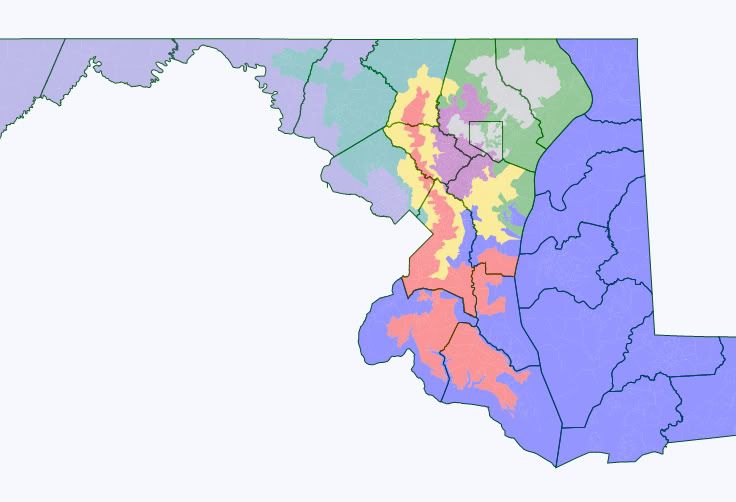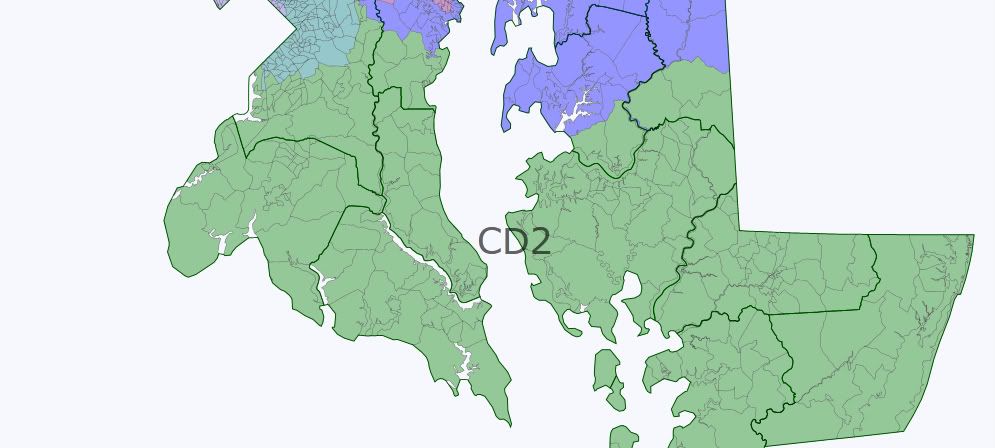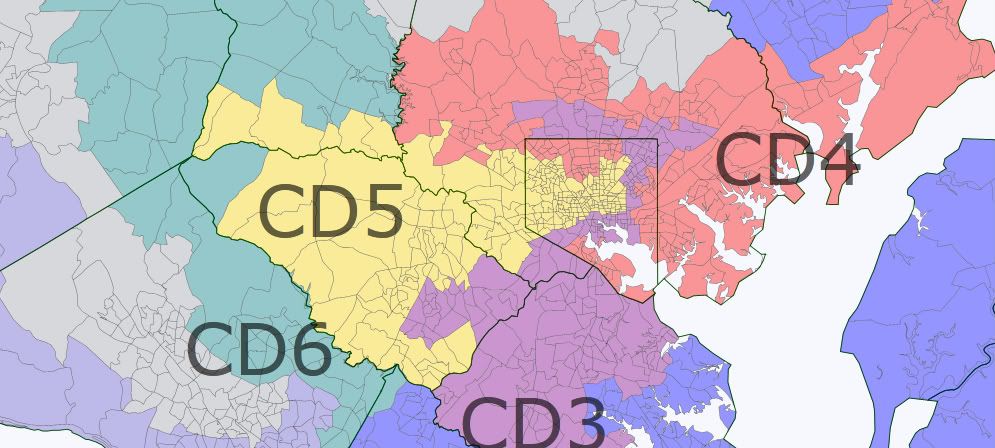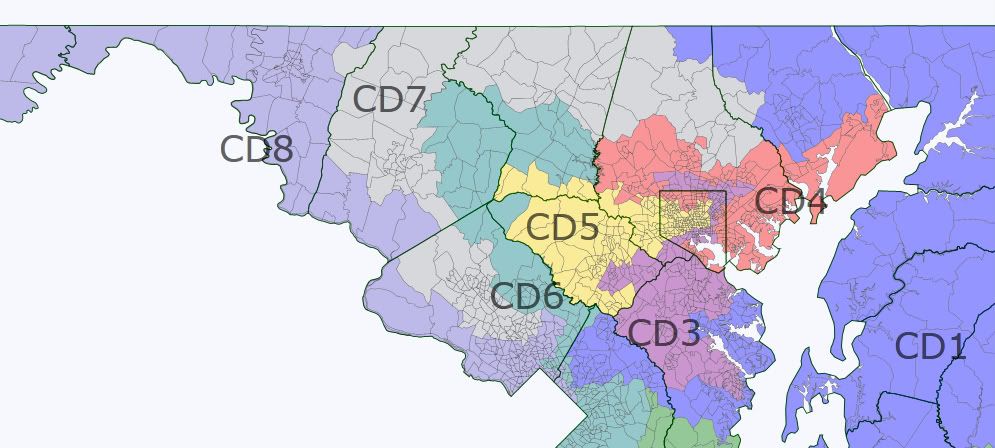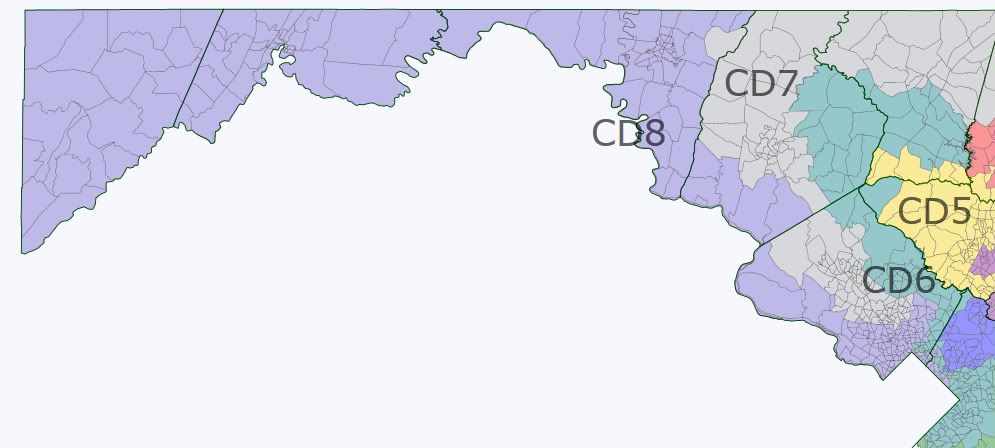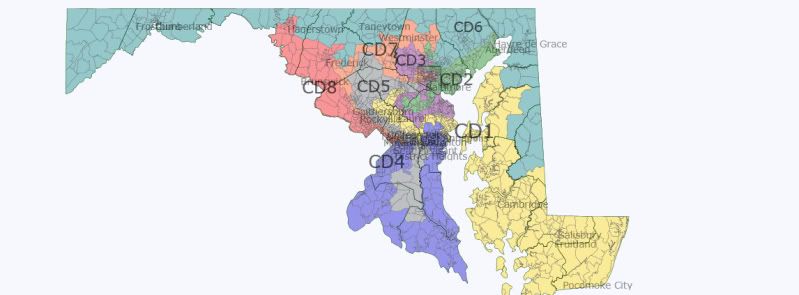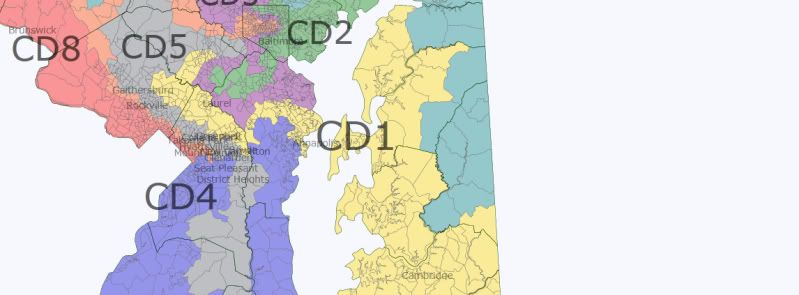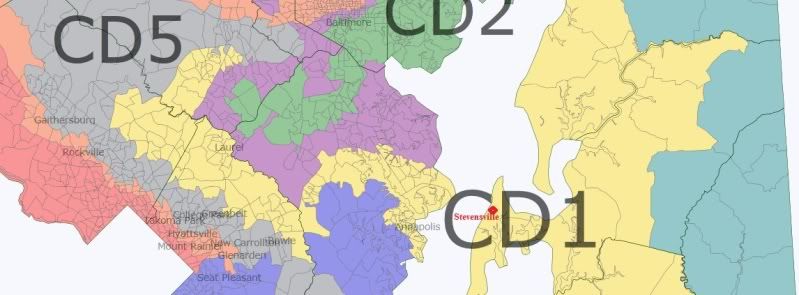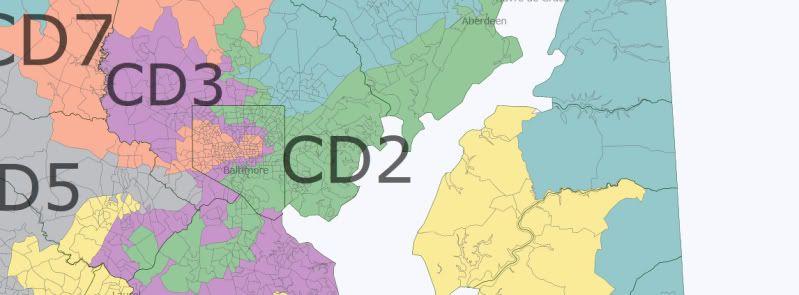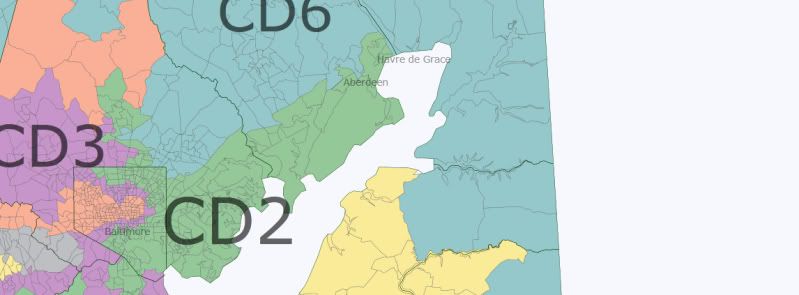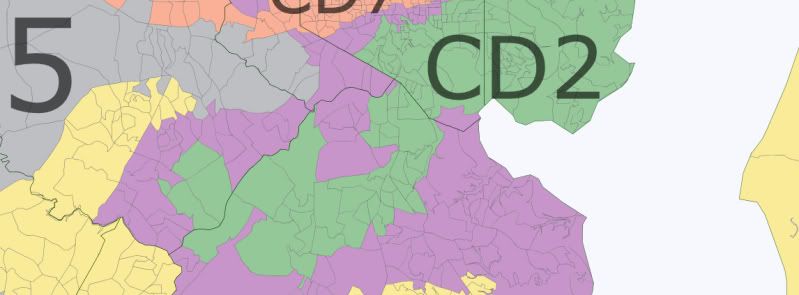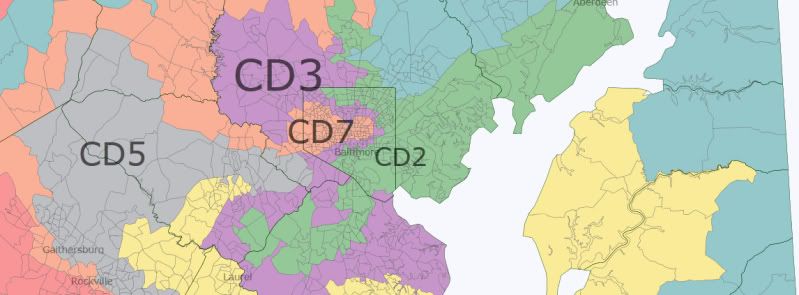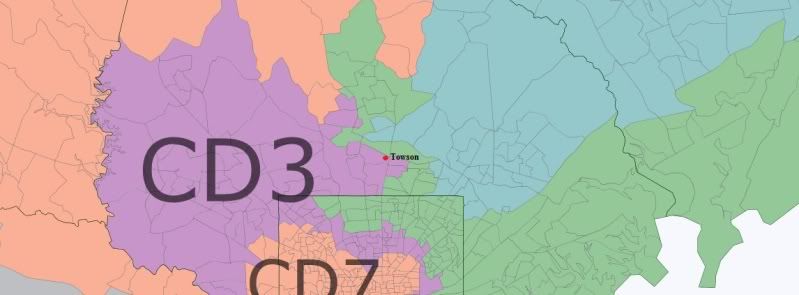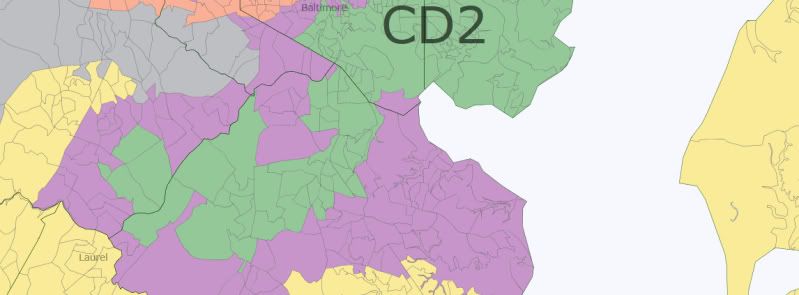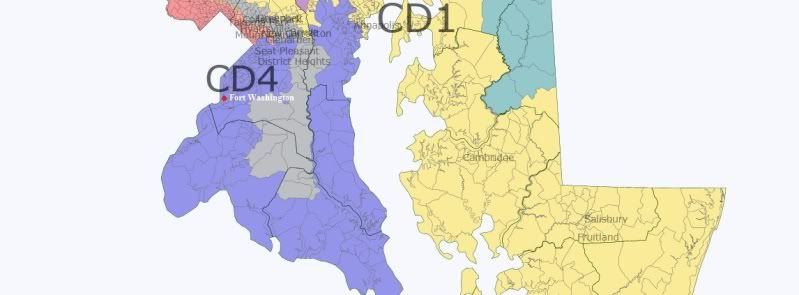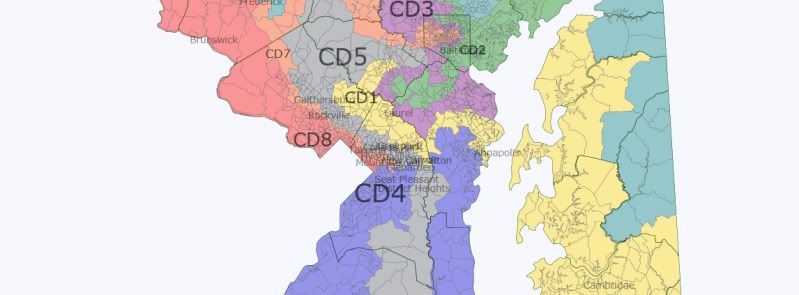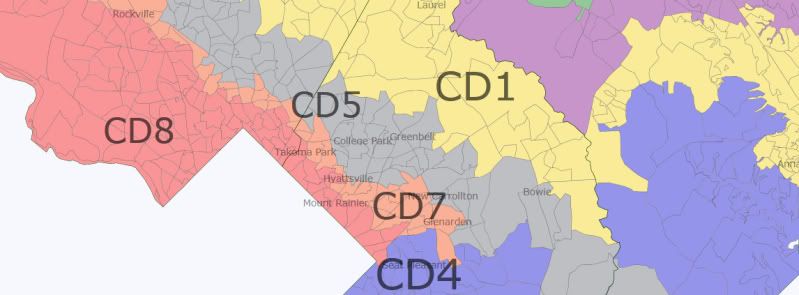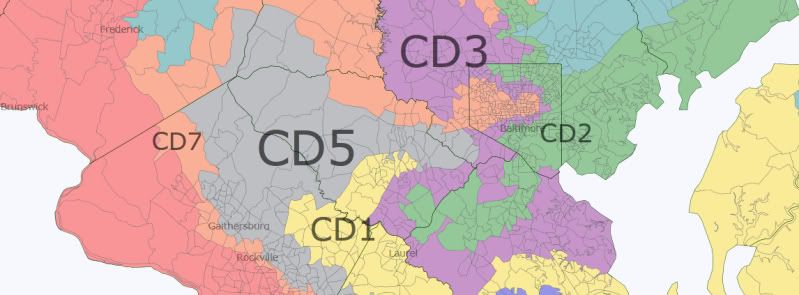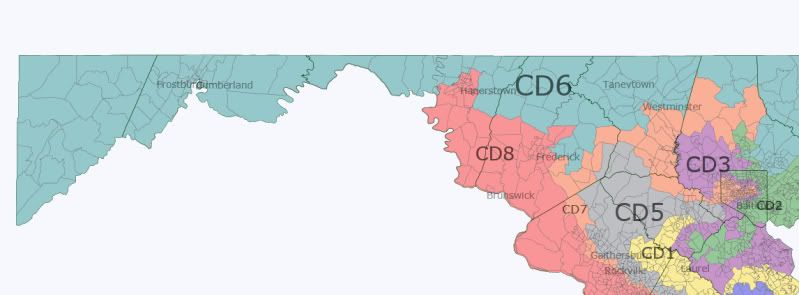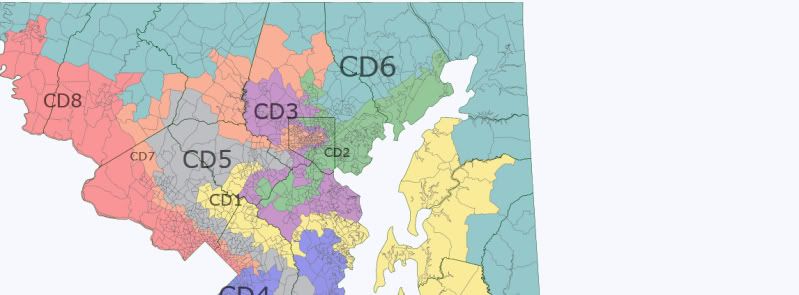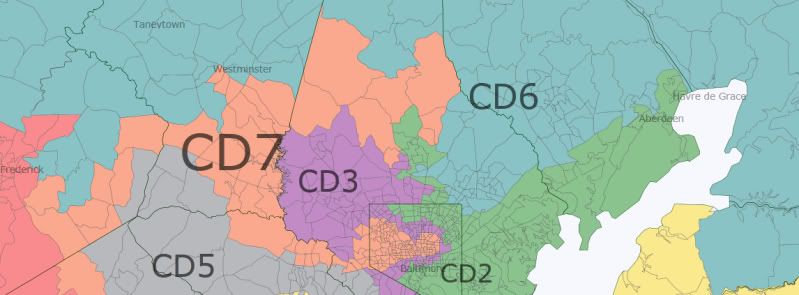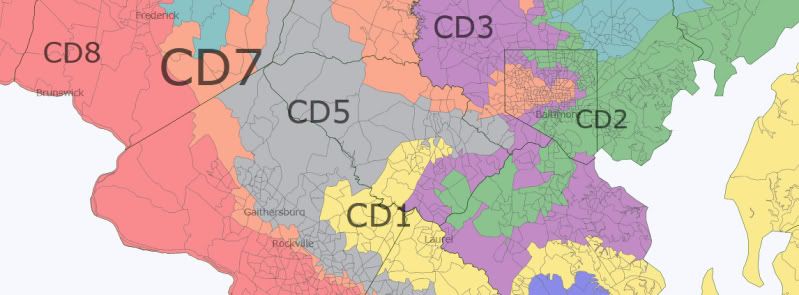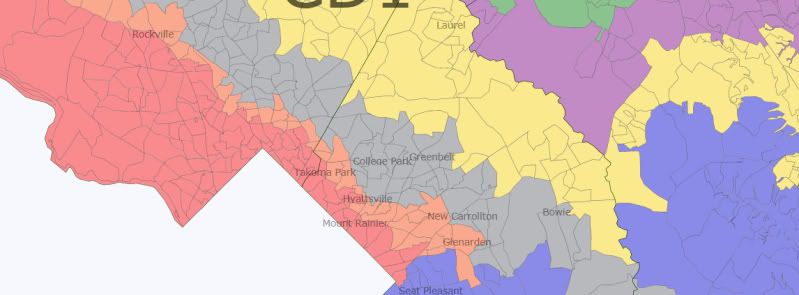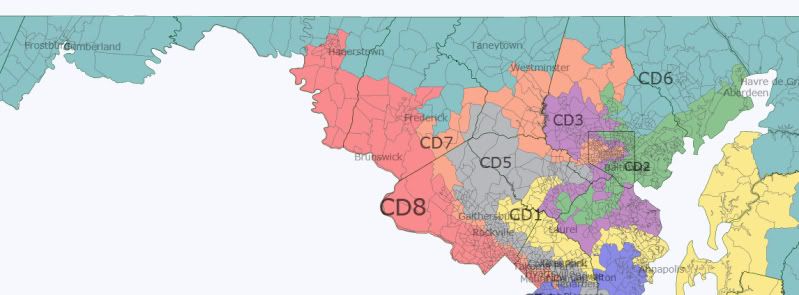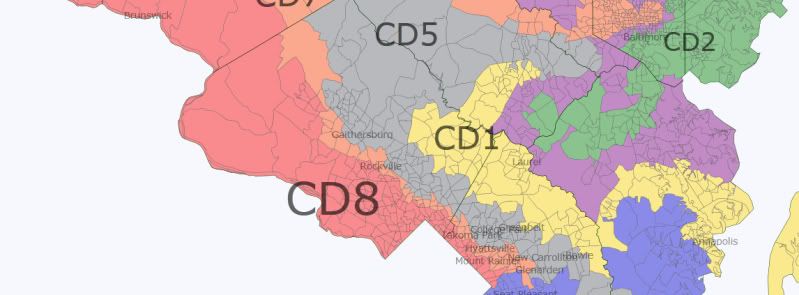This is my version of Maryland using Daves Redistricting 2.1. Looking at the 2010 Census data incorporated into the Application, I see no reason at all why Democrats should not create an 8-0 map.
Actually, I drew a couple versions of a map. The main part of this diary deals with “Version 1”, an 8-0 map which I believe would have the best chance of being enacted in Maryland. My alternative “Version 2” is discussed at the end of the diary.
VERSION 1
This map preserves both black majority seats, keeps the districts of all six Democratic incumbents safely Democratic and creates two additional Democratic seats — all without creating a “monstrous” looking map.
Another very important goal for me was to keep as much of each incumbent’s current territory (population-wise) in the new district. The percentages of current constituents that each district gets to keep are below:
MD-1 – 64.8%
MD-2 – 65.1%
MD-3 – 58.2%
MD-4 – 57.9%
MD-5 – 64.6%
MD-6 – 60.1%
MD-7 – 51.8%
MD-8 – 58.0%
I feel that the set of numbers above is just as important as the partisan numbers for each district. In many cases, if an incumbent loses too much of his or her existing constituents, they may not like the map even if their district becomes more favorable in terms of party identification. Thus any map that has a realistic chance of being enacted in Maryland must pay close attention to how a proposed district resembles the existing district.
As you can see from the numbers above, each incumbent save one gets to keep at least 58% of their current constituents. As for MD-7, Cummings keeps only 52%. However, that number comes with a caveat — because an additional 13.9% of the proposed MD-7 here comes out of African-American areas in Baltimore City (Cherry Hill, for example) or Baltimore Co. (Randallstown) that are currently part of MD-2 or MD-3. These added areas are 75% black, so even though Cummings currently doesn’t represent them, there’s no reason these new constituents would not be receptive to being represented by Cummings.
UPDATE: please note that per suggestion from one reader, I have adjusted the map to do a better job at keeping suburban Baltimore communities together; this change had the added benefit of making Cummings keep more of his current MD-7 constituents — now 55.1% (please see comments section for more info.)
The black percentage in the two black majority districts goes down slightly from the current percentages, but the proportion of African-Americans as a percentage of the Democratic primary vote in both districts is very high — by my estimate it’s at least 77% in MD-4 and at least 82% in MD-7 (sic) ! — so these districts should have no trouble in electing an African-American representative.
The districts of all six Democratic incumbents are kept at least 60% Obama and at least 60% Democratic Average 2006-2008. The two new Democratic districts are made to be 53.7% Obama for MD-1 and 55.6% Obama for MD-6. Both the new MD-1 and the new MD-6 are at exactly 52.9% Democratic Average 2006-2008. I feel that is enough of a cushion in both cases. For MD-1, Kratovil should easily win a 53-54% Democratic district. Most of the area in the new MD-6 (Frederick area and northern Montgomery Co.) is becoming more and more Democratic every year, as evidenced by the Democrats take-over of State Senate District 3 (Frederick) this past November. I could have made the new MD-6 a bit more Democratic, but I did not want to endanger Van Hollen or make the lines too convoluted (for example, you could add Carroll Co. to MD-4, like I did in a previous diary and here under “Version 2”, but it just seems like a bridge too far in any map that has a realistic chance of being enacted; in this respect, much of what constitutes drawing a map is quite subjective). The new MD-6 here should turn blue, unless a very, very moderate Republican is the nominee — which isn’t going to happen these days !
Partisan numbers for new districts are below:
MD-1 – 53.7 Obama; 52.9 Democratic Avg. 2006-2008
MD-2 – 60.9 Obama; 63.8 Democratic Avg. 2006-2008
MD-3 – 60.2 Obama; 60.7 Democratic Avg. 2006-2008
MD-4 – 82.5 Obama; 79.1 Democratic Avg. 2006-2008
MD-5 – 60.9 Obama; 60.9 Democratic Avg. 2006-2008
MD-6 – 55.6 Obama; 52.9 Democratic Avg. 2006-2008
MD-7 – 73.5 Obama; 69.7 Democratic Avg. 2006-2008
MD-8 – 64.7 Obama; 64.9 Democratic Avg. 2006-2008
Where possible, I tried to respect county and community lines while drawing this map (see the fourth map down where city lines and Census-designated community lines in central Maryland are mapped).
The population deviation for this map is +/- 132 persons, with the caveat that Maryland has a new law now where the prison population may have to be “reassigned” to district of origin. For demographics below, I noted ethnic/racial group if 5%+ of the population. Please note that all the data below for current and proposed districts is obtained from Daves Redistricting Application. I drew in the existing districts into the Application to obtain demographic data as it currently stands for each district. Please note that for partisan data, it appears that the percentages provided in the Application are percentages as a proportion of the two-party vote.







District 1:
Current District Population: 81.0 white, 11.4 black
Proposed District Population: 66.0 white, 24.7 black, 5.2 hispanic
Current District 18+ Population: 82.8 white, 11.1 black
Proposed District 18+ Population: 68.5 white, 23.8 black
Current District President: 41.5 Obama, 58.5 McCain
Proposed District President: 53.7 Obama, 46.3 McCain
Current District Partisan Avg. 2006-2008: 41.8 Democratic, 58.2 Republican
Proposed District Partisan Avg. 2006-2008: 52.9 Democratic, 47.1 Republican
District 2:
Current District Population: 55.2 white, 33.1 black, 5.0 hispanic
Proposed District Population: 62.6 white, 24.9 black, 5.4 hispanic
Current District 18+ Population: 59.2 white, 30.8 black
Proposed District 18+ Population: 66.5 white, 22.4 black
Current District President: 60.8 Obama, 39.2 McCain
Proposed District President: 60.9 Obama, 39.1 McCain
Current District Partisan Avg. 2006-2008: 63.4 Democratic, 36.6 Republican
Proposed District Partisan Avg. 2006-2008: 63.8 Democratic, 36.2 Republican
District 3:
Current District Population: 65.2 white, 20.0 black, 6.8 hispanic, 5.3 asian
Proposed District Population: 60.0 white, 21.9 black, 8.7 asian, 6.1 hispanic
Current District 18+ Population: 68.2 white, 18.7 black, 6.0 hispanic, 5.2 asian
Proposed District 18+ Population: 62.9 white, 21.0 black, 8.6 asian, 5.4 hispanic
Current District President: 60.5 Obama, 39.5 McCain
Proposed District President: 60.2 Obama, 39.8 McCain
Current District Partisan Avg. 2006-2008: 62.3 Democratic, 37.7 Republican
Proposed District Partisan Avg. 2006-2008: 60.7 Democratic, 39.3 Republican
District 4:
Current District Population: 55.7 black, 20.6 white, 14.2 hispanic, 6.9 asian
Proposed District Population: 53.2 black, 24.7 white, 13.0 hispanic, 6.5 asian
Current District 18+ Population: 55.5 black, 22.3 white, 12.9 hispanic, 7.2 asian
Proposed District 18+ Population: 53.0 black, 26.2 white, 11.9 hispanic, 6.7 asian
Current District President: 86.1 Obama, 13.9 McCain
Proposed District President: 82.5 Obama, 17.5 McCain
Current District Partisan Avg. 2006-2008: 82.6 Democratic, 17.4 Republican
Proposed District Partisan Avg. 2006-2008: 79.1 Democratic, 20.9 Republican
District 5:
Current District Population: 48.0 white, 36.7 black, 7.9 hispanic
Proposed District Population: 56.4 white, 27.9 black, 9.5 hispanic
Current District 18+ Population: 50.8 white, 35.6 black, 6.9 hispanic
Proposed District 18+ Population: 58.7 white, 27.2 black, 8.4 hispanic
Current District President: 67.0 Obama, 33.0 McCain
Proposed District President: 60.9 Obama, 39.1 McCain
Current District Partisan Avg. 2006-2008: 65.8 Democratic, 34.2 Republican
Proposed District Partisan Avg. 2006-2008: 60.9 Democratic, 39.1 Republican
District 6:
Current District Population: 85.0 white, 6.4 black
Proposed District Population: 66.4 white, 11.0 hispanic, 10.6 black, 9.2 asian
Current District 18+ Population: 86.8 white, 6.4 black
Proposed District 18+ Population: 69.0 white, 10.0 black, 9.9 hispanic, 9.3 asian
Current District President: 41.3 Obama, 58.7 McCain
Proposed District President: 55.6 Obama, 44.4 McCain
Current District Partisan Avg. 2006-2008: 40.0 Democratic, 60.0 Republican
Proposed District Partisan Avg. 2006-2008: 52.9 Democratic, 47.1 Republican
District 7:
Current District Population: 55.7 black, 31.6 white, 6.7 asian
Proposed District Population: 55.0 black, 38.2 white
Current District 18+ Population: 54.6 black, 33.6 white, 6.7 asian
Proposed District 18+ Population: 54.1 black, 39.9 white
Current District President: 81.8 Obama, 18.2 McCain
Proposed District President: 73.5 Obama, 26.5 McCain
Current District Partisan Avg. 2006-2008: 76.6 Democratic, 23.4 Republican
Proposed District Partisan Avg. 2006-2008: 69.7 Democratic, 30.3 Republican
District 8:
Current District Population: 47.5 white, 20.0 hispanic, 16.3 black, 13.3 asian
Proposed District Population: 63.3 white, 13.6 black, 12.6 hispanic, 7.9 asian
Current District 18+ Population: 49.6 white, 18.6 hispanic, 16.1 black, 13.5 asian
Proposed District 18+ Population: 65.0 white, 13.6 black, 11.5 hispanic, 8.1 asian
Current District President: 76.0 Obama, 24.0 McCain
Proposed District President: 64.7 Obama, 35.3 McCain
Current District Partisan Avg. 2006-2008: 75.1 Democratic, 24.9 Republican
Proposed District Partisan Avg. 2006-2008: 64.9 Democratic, 35.1 Republican
VERSION 2
The map below is my alternative version. There’s only one difference from Version 1: Carroll Co. is added to MD-4 while almost everything that’s in Montgomery Co. and part of MD-4 under Version 1 is now added to MD-6. This exchange between MD-4 and MD-6 produces the following demographic and partisan numbers:
District 4:
Proposed District Population: 50.5 black, 33.1 white, 10.5 hispanic
Proposed District 18+ Population: 50.3 black, 34.5 white, 9.7 hispanic
Proposed District President: 75.7 Obama, 24.3 McCain
Proposed District Partisan Avg. 2006-2008: 72.6 Democratic, 27.4 Republican
District 6:
Proposed District Population: 58.0 white, 13.4 hispanic, 13.3 black, 12.1 asian
Proposed District 18+ Population: 60.9 white, 12.5 black, 12.3 asian, 12.2 hispanic
Proposed District President: 62.3 Obama, 37.7 McCain
Proposed District Partisan Avg. 2006-2008: 59.3 Democratic, 40.7 Republican

The “Version 2” map turns MD-6 into something that’s safely Democratic (instead of just a lean/likely Democratic seat under Version 1), but reduces the black percentage in MD-4 — though it remains above 50%. The reduction in the African-American population in MD-4 may be retrogressive — however, it should be noted that the white population remains a relatively low percentage, and amazingly, according to my estimate, the proportion of African-Americans as a percentage of the Democratic primary vote in MD-4 now goes UP to 84%. Another problem would be that Edwards would only get to keep 39% of her existing constituents under these revised lines.
Last, but not least, I must add that I absolutely love version 2.1 of Daves Redistricting Application !

Loading ...

